The 5 Best Bike Trainer Tires in 2020
So you just bought a roller or trainer for your indoor cycling sessions and then realized that your usual bike tires won’t stand up to the demands. Technically, you can use the tires, but keep in mind that they’re designed for the tarmac, not the trainers.
This then leads to some of the common questions such as,
- Do I need a special tire for a bike trainer?
- Can my road tires withstand the demands of the indoor trainers?
- Are bike trainers hard on tires?
On this page, I’ll discuss why you’ll need a set of trainer-specific tires and also share some of the models available out there.
Vittoria Zaffiro Pro
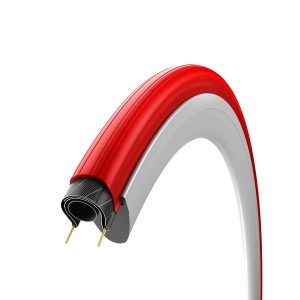
Vittoria has been in the tires game since 1953, and from the Zaffiro Pro Home Trainer, their flagship trainer tire it’s clear they’ve been taking notes.
The Home Trainer is the indoor version of the company’s workhorse tire, and it has three huge advantages; durability, comfort, and low cost.
Manufactured in vibrant red so you know not to take it out on the road, the heat-dissipating tread and quality rubber construction save on wear and tear.
It’s also remarkably quiet, one of the most desirable features in a trainer tire, and it combines easily with a wide array of indoor trainers.
- Pros : Very quiet.
- Cons : Red color is not to everyone’s liking.
Continental Hometrainer
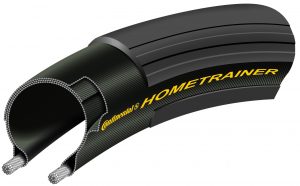
Founded in 1871, Continental is one of the oldest names in tires, and a familiar name to cyclists for their solidly-built, reliable tires. The introductory model in Continental’s Hometrainer line, this folding tire has just about everything one could expect from a rugged, basic bike trainer tire.
The Hometrainer is popular among road cyclists for its easy installation, and its smooth construction makes for terrific noise reduction.
Made with a stiffened casing and a special cold-running compound to resist heat buildup, it also offers impressive resistance to tread separation under constant contact with the trainer’s resistance unit.
- Pros : Durable construction that will last more than a season on the trainer.
- Cons : Expect to pay more.
Tacx Trainer Tire
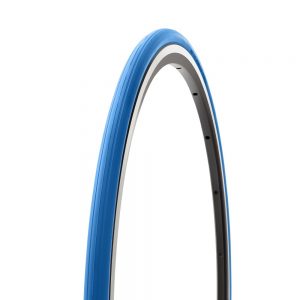
Tacx is a big player when it comes to bike trainers, so it should come as no surprise that their proprietary trainer tire is a solid product for heat resistance, noise reduction, and performance.
It’s constructed from a heat-dissipating rubber compound with low rolling resistance, in blue to avoid accidental road usage. It also has exceptional traction, providing a road-like feel while training without the slippage common in lower-quality trainer tires.
Tacx trainer tires are known to last for hundreds of trainer miles, even thousands, and they’re compatible with trainers from other manufacturers, as well making it a great choice.
- Pros : Smooth and quiet ride.
- Cons : Expect to pay more.
Kinetic by Kurt
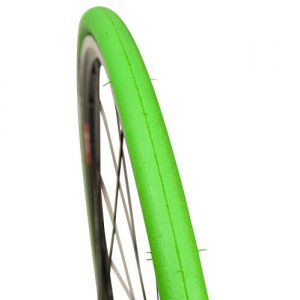
Minneapolis-based Kinetic by Kurt excels at one thing above all; trainers and trainer accessories. While the company recommends this tire be used with its own trainer, it can be easily used with other brands.
Consisting of a special rubber compound developed in partnership with Taiwanese tire manufacturer Kenda, these tires are specifically engineered to work with trainer rollers while resisting wear and heat buildup.
It is designed to fit road bikes with 700c wheels and is made in an eye-watering green to let you know not to use it on the road.
- Pros : Quiet with superior ride feel especially on rollers.
- Cons : Installation can hard depending on your wheels.
Schwalbe Insider
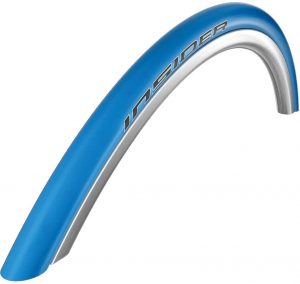
The bright blue Insider comes with a folding bead, fits with a range of wheel sizes and widths, and weighs in at a sturdy 270g.
It can be inflated to between 100-145 psi, although you might find you want to keep it on the lower end of that range to be kind to your inner tubes.
They also offer some pretty solid customer service, with a three-year warranty from the sale date or five years from the manufacture date, whichever comes first. The Insider is ideal for first-timers and occasional users, offering a quiet grippy ride for indoor sessions.
- Pros : Solidly built that will withstand a lot of mileage on the trainers and rollers.
- Cons : Expect to pay more compared to its peers.
Why You Should Use Indoor Trainer Tires
If you’re looking to get some training time in from the comfort of your own home, a good bike trainer tire is an essential piece of equipment.
But it’s easy to be skeptical.
- Why shouldn’t you just use an old road tire?
- What benefit do they have?
- And will they even work with your gear?
These are all great questions, and fortunately, we have answers.
Here are three factors to consider when looking into trainer tires that should help you make an informed decision when it comes time to purchase one.
1. Designed for Traction
One of the key features of any trainer tire is traction.
Indoor cycling is obviously a different environment from the road or the trail, so no matter how convincing your simulation app may be, you’ll want to adapt accordingly for the different surfaces and conditions.
Trainer tires are made from tough materials with specialized treads for increased traction since they have to work together with a trainer rather than a road surface.
With a trainer’s rollers, you’ll need something with a fair bit of grip to make sure you aren’t sliding through your training to a disappointing finish. With smoother surfaces comes the need for extra resistance to make sure you’re getting the most out of your training sessions.
2. Increased Durability
Since trainer tires are constructed from thicker, sturdier materials to keep up with the pressure and friction from machine usage, they’re much more durable than last season’s worn-out road tires.
A more durable tire means more savings for you in the long run, which is exactly what you want to save your money for some really top-notch road tires.
With a long-lasting indoor tire, you can expect long use out of a smart purchase, allowing you to train for longer without worrying about your wallet.
3. Better Heat Resistance
You might have guessed it, but all that friction from the rollers can only mean one thing, heat.
The last thing you need from your training is smoke in your garage, so trainer tire manufacturers take this into account when designing and producing their products.
If you insist on using a regular tire, be warned; it won’t take long for your trainer to wear through a tire that wasn’t built to take the amount of heat produced, and it can even melt the rubber, leaving a coating that will reduce traction and make for a disappointing session.
Author Recommended Reads
